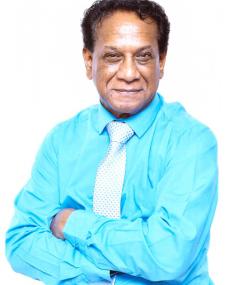
Guru Kistnasamy was born on 28 December 1947 in Felixton, Zululand, Natal (now KwaZulu-Natal). His father, Thaniachallam Kistnasamy Naicker, worked as a builder at the local Huletts Sugar Mill and his mother, Shanbagavalli, was a housewife.
Kistnasamy attended the Felixton Government-Aided Indian Primary School state–aided primary school consisting of one large classroom divided into two, catering for all children from Class One (Grade 1) to Std. VI (Grade 8). The school had a “platoon” section that catered for the overflow of children in the afternoon; so there was a “morning school” and an “afternoon school”. Classes were also conducted outside under the trees. Rainy weather meant school had to close for the day.
The nearby high school, Felixton High School, was exclusively for White children. After Std.VI (Grade Eight), Kistnasamy left home in 1964 to attend Chatsworth High School, located in Chatsworth, an area set aside for Indians under the then Group Areas Act.
He became politicized facing the injustices of the apartheid government. The restriction of movement, the poverty of people, the suppression of protest, the false mentality of White supremacy, and other prevailing conditions led to his involvement in political activism as a student.
On 6 September 1966, Dr. Hendrik Verwoerd, the prime minister of South Africa, the architect of apartheid was assassinated. Soon after Dr Verwoerd’s death a special assembly was conducted at school. The principal announced the death of Verwoerd. The silence that ensued was broken by a single student clapping. Needless to say Kistnasamy was dragged out of assembly and hauled over the coals.
Republic Day was celebrated on the 31 May of each year by the government. School principals would raise the flags at assembly. Sweets and cold drinks were given to students. It was a celebration of apartheid. Late that night a friend and Kistnasamy proceeded to cut the ropes of the flags. They did this at Chatsworth High and the neighbouring Protea High Schools. In addition, they painted anti-government slogans on the school walls. Assembly at school the next day was a glum ceremony. The police were called. The ropes were re-tied. The search for the suspect began.
His first brush with the notorious Special Branch of the South African Police occurred at school. He was called to the principal’s office and unceremoniously handed over to them. He was targeted as a potential suspect following the “clapping incident” following Verwoerd’s death. There was a White lieutenant and two Indian special branch officers who took him to the local police station in Bayview, Chatsworth, where he experienced his first interrogation. Kistnasamy was warned and released. The incident left him traumatized but more determined to fight an illegitimate government.
After matriculation, he enrolled at the Transvaal College of Education (TCE), in Fordsburg, Johannesburg where he was elected president of the Students Representative Council (SRC). The SRC affiliated to the National Union of South African Students (NUSAS). Here they met leaders such as Duncan Innes, Neville Curtis, Horst Kleinschmidt, Paul Pretorius, Rob Davies and others.
Kistnasamy later met Steve Biko and they became friends. The TCE SRC attended the South African Student Organisations (SASO) inaugural congress at the University of the North (Turfloop) in 1969 where Biko was elected President. Kistnasamy was elected Vice-president for Cultural Affairs. However, he later had to resign due to pressure from the TCE rector. By then the TCE SRC had disaffiliated from NUSAS.
Steve Biko visited the TCE campus but was not allowed to address the students. He stayed over at the house that Kistnasamy lived in Lenasia, Transvaal (another area designated for Indians to live under the Group Areas Act). They later promoted speech contests and debates amongst Black students only at schools in the area.
TCE students and the public were involved in the protests after the death Ahmed Timol, who was thrown out of the window of the tenth floor of police headquarters at John Vorster Square by the Security Police. His death on 28 October 1971 rallied students to the cause.
The special branch then cracked down country wide on political dissidents. The infamous October raid was carried out. They raided the house next door but Kistnasamy managed to escape the net as the neighbour said that nobody by his name on the list lived there. Some 115 homes were raided in Johannesburg during this crackdown.
As a teacher in Durban in 1973 he joined the Teachers Association of South Africa (TASA) and was elected Chairman of the Welbedacht branch in 1979/80. In 1988 he was elected Vice-President of TASA responsible for the portfolio of Teacher Welfare. TASA later led the move to merge with the South African Democratic Teachers Union (SADTU).
Kistnasamy was visited by the special branch at home during the student protests. A Colonel Nayagar from the Security Police, threatened to confiscate his passport, and have him arrested if he continued with his political involvement. The special branch was all over, at every protest and meeting. To dodge them Kistnasamy and his colleagues used to hold their meetings in a church. The police followed them everywhere and kept their homes under observation.
The release of Nelson Mandela and the installation of a democratic government gave him freedom at last.
In 1987 Kistnasamy was awarded a scholarship and studied for his M.Ed degree at Harvard University in the United States of America. He then completed his Ph.D at the University of Zululand in 2007.
Presently he is in private practice as a psychologist. He is involved in the community—a member of the Chatsworth Hospice Board, counsellor at a rehabilitation centre, and has established a remedial centre to help children with scholastic weaknesses. He also writes a weekly column for a community newspaper.